The origins of this article trace back to a distant past.
Indeed, my first trip to Sicily was a gift from my parents to celebrate my high school graduation.
The vibrant colors, exquisite flavors, captivating art, and the warm hospitality of the locals instantly captured my heart and ignited my love for this land.
It took me 34 years to return, but the wait was truly worthwhile.
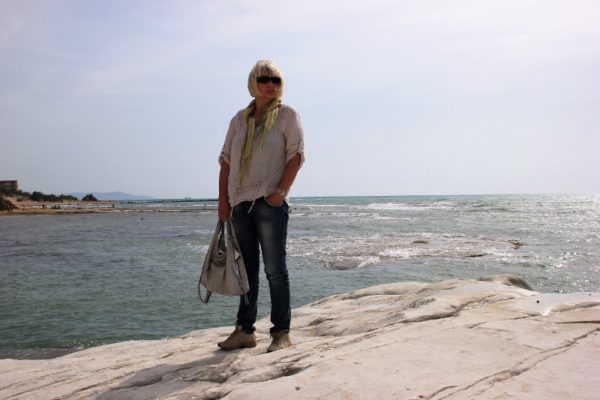
The beach of Realmonte
For our long-awaited return, we meticulously planned a ten-day itinerary, spanning from Catania to Agrigento, encompassing some of the most breathtaking destinations in southeastern Sicily.
Drawing from our personal experience, we highly recommend dedicating a minimum of three full days to Agrigento and its surrounding areas.
This region is ideal for those seeking a leisurely and sustainable travel experience, where cultural exploration seamlessly intertwines with genuine and authentic encounters.
You can walk along the narrow streets that gracefully ascend the hills, pause at natural vantage points to admire the distant sea, and venture into an olive mill to witness the fascinating process of olive oil production.
It is important to note that, in this article, our focus solely revolves around the enchanting attractions surrounding Agrigento, Sicily, intentionally omitting the exploration of the city itself.
Table of Contents
Places to Stay in the Vicinity of Agrigento, Sicily
If you seek a serene haven immersed in nature, where peace and tranquility reign supreme, Agriturismo La Casa di Bacco is the perfect destination for you.
Nestled atop a hill, approximately 300 meters above sea level, this charming establishment is enveloped by a breathtaking landscape.
The rolling slopes adorned with vineyards and olive groves paint a picturesque scene, while in the distance, the distinct silhouette of Agrigento and its towering structures captivate the horizon.
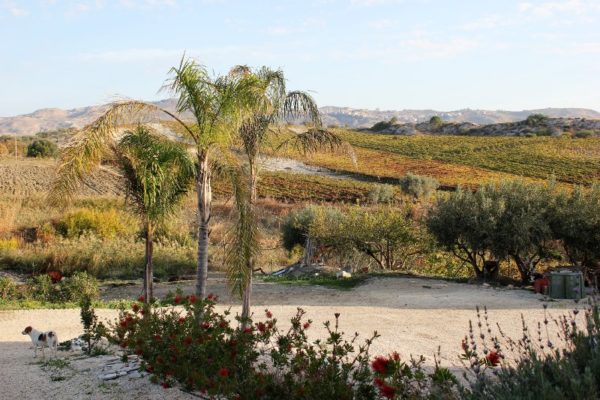
View from the Agriturismo “La Casa di Bacco”
The ever-changing play of sunlight casts a mesmerizing array of colors across the landscape, each shade varying with the angle and intensity of its rays.
However, it is during the late afternoon when the scenery reaches its pinnacle of beauty, as the hues transition into warm and embracing tones.
At Agriturismo La Casa di Bacco, the Martorana family, renowned for their warm hospitality, is at the heart of this idyllic retreat.
Relax amidst the garden’s comfortable wicker armchairs, or indulge in an aperitif on the panoramic terrace, soaking in the picturesque surroundings.
The farm takes pride in its production of exceptional red wines, with a special emphasis on showcasing indigenous grape varieties, including the renowned Nero d’Avola.
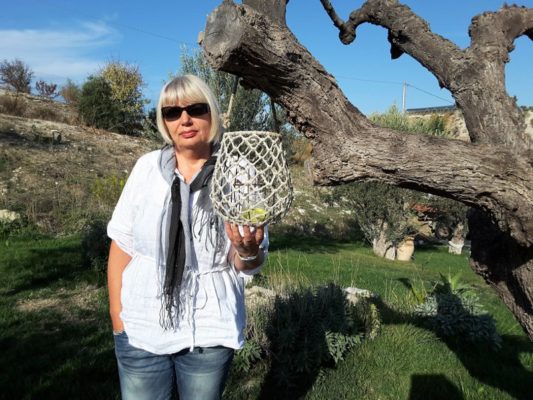
The garden of the Agriturismo “La Casa di Bacco”
As you walk along a path surrounded by vineyards, you’ll arrive at a charming little farm that is sure to bring joy to both young and old with its collection of friendly farm animals, including donkeys and a small flock of sheep.
To reach the farm from Agrigento, follow these simple directions: upon reaching the village of Villaseta, take the road that leads to the town of Piano Gatto.
Just before you start ascending towards the cemetery, make a left turn and continue following the signs that guide you to the farm.
Keep following the signs, and they will lead you to Contrada Ragabo, where the farm is located.
Here you can check the offers and availability of
Must-Visit Attractions Near Agrigento
When exploring the surroundings of Agrigento, we allocated two full days, in addition to one day dedicated to the city itself.
However, as time is often a limiting factor, we had to carefully select our itinerary, sacrificing some places in favor of others.
If you have more time at your disposal, we recommend expanding your tour to include other captivating destinations.
For instance, the delightful seaside resort of Sciacca is a worthwhile visit.
You can also explore the small archaeological site of Eraclea Minoa or visit the town of Porto Empedocle, the birthplace of renowned italian author Andrea Camilleri.
During our itinerary, we opted for the convenience of renting a car through DiscoverCars, a reliable online platform that compares prices from various companies.
The “free cancellation” option offered us flexibility and protection against any unforeseen circumstances up until the day before departure.
The Magnificent Valley of the Temples
Situated just five kilometers away from Agrigento, Sicily, the Valley of the Temples is a remarkable archaeological site renowned for its captivating beauty in the Mediterranean region.
You can explore the Valley of the Temples independently or choose to join a private guided tour, which we highly recommend due to the historical, artistic, and cultural significance of the site.
The guided tour lasts approximately two or three hours, depending on your ticket choice, with an expert guide providing insights in English.
Multiple time slots are available throughout the day, offering flexibility in planning your visit.
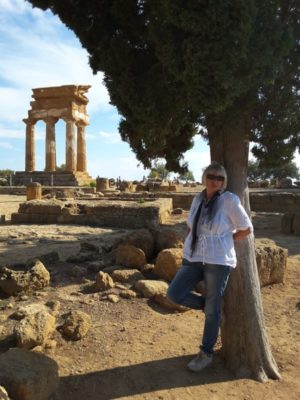
The Valley of the Temples in Agrigento, Sicily
Renowned playwright Luigi Pirandello once referred to the Valley of the Temples as “the forest of almond and olive trees.”
This description aptly captures the abundant presence of olive trees in the uncultivated and neglected areas, while both ancient and recently transplanted olive trees can be found in the cultivated areas, yielding the exquisite Diodòros olive oil.
Recognized as a UNESCO World Heritage Site, the Valley of the Temples boasts the best-preserved Doric temples outside of Greece.
Divided into two distinct sections, the western and eastern areas are connected by a bridge that spans over the SP4 road.
At the end of each section, you’ll find supervised parking lots and ticket offices, one located near the Temple of Juno and the other near Porta V.
If you have the opportunity to choose the time of your visit, we recommend arriving in the mid-afternoon, as the monuments showcase their most vibrant colors during the enchanting sunset.
The perfect combination of yellow ochre and brown harmonizes seamlessly with the surrounding environment, creating a truly mesmerizing sight.
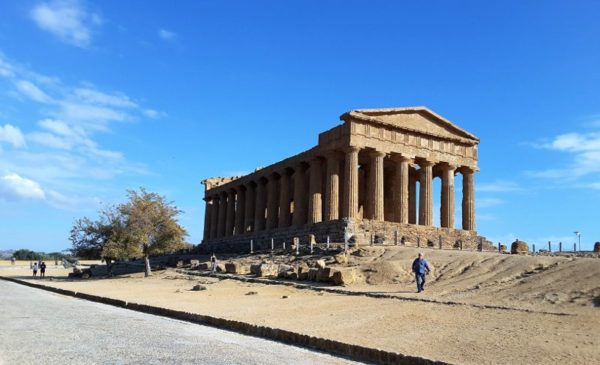
Temple of Concordia
The eastern area of the Valley of the Temples houses the most captivating attractions, including the Temple of Hercules, the magnificent Temple of Concordia, and the Temple of Juno.
These ancient structures are truly remarkable and worth exploring.
In addition to the temples, we highly recommend a visit to the Archaeological Museum, located in the same area.
Here, you can delve deeper into the history of ancient Akragas (old Agrigento) through a diverse collection of artifacts, further enriching your experience.
Within the eastern area, near the Via Sacra, you’ll come across an enclosure that houses a selection of Girgentana goats.
Originally from Afghanistan and Balochistan, these goats were introduced to Europe and southern Sicily by Arabs and Greeks.
The native Girgentana breed is characterized by its distinctive white and thick coat, as well as its elegantly twisted and upright horns.
Over the years, the Girgentana breed has faced the risk of extinction due to a decline in population and breeders.
However, through specific programs aimed at conservation and reintroduction, the species has been successfully reintroduced to various regions, including the Valley of the Temples.
This initiative has contributed to the preservation and revitalization of this unique and treasured breed.
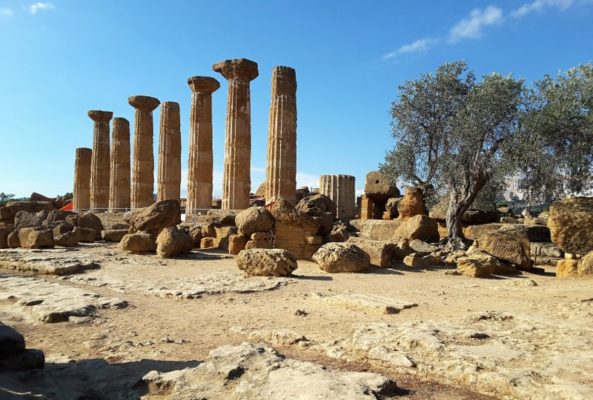
Temple of Jupiter
Occasionally, veer off the main path and take a moment to pause and appreciate the surrounding wonders from different perspectives.
Find a secluded spot where you can reflect on the remarkable achievements of mankind a few centuries before the birth of Christ.
In the western area of the Valley of the Temples, make sure to visit the Temple of Jupiter, the Temple of the Dioscuri, and the beautiful Kolymbethra Garden.
The Valley of the Temples is open every day from 8:30 am to 7:00 pm.
During the summer months, the archaeological site extends its opening hours into the evening, allowing visitors to witness the temples illuminated by skillful plays of light.
This creates a truly magical atmosphere and provides a captivating spectacle for all to enjoy.
The Enchanting Scala dei Turchi
Located just 14 kilometers from Agrigento, on the outskirts of the village of Realmonte, lies a natural wonder that dazzles with its radiant white color—the Scala dei Turchi, or the “Stair of the Turks.”
The Scala dei Turchi is a breathtaking cliff that gracefully extends towards the sea.
It is composed of sedimentary rock, characterized by its calcareous and clayey nature.
Rising between two renowned beaches of Agrigento, this formation holds a significant historical significance as well.
The name “Scala dei Turchi” derives from the Arab and Turkish pirates who sought refuge in this area during storms, taking advantage of its natural protection from the winds.
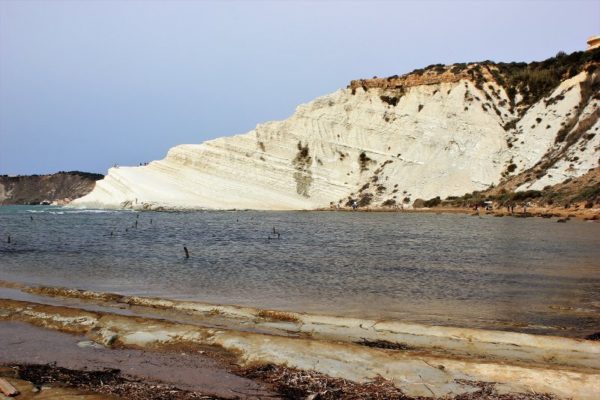
The Scala dei Turchi
In recent years, the Scala dei Turchi has faced various challenges. Initially, geological instability caused by erosion posed a threat to its structure.
Moreover, in early January 2022, the site fell victim to vandalism, further adding to the challenges it has encountered.
Reaching the Scala dei Turchi is a straightforward task. Once you arrive in the village, simply follow the directional signs that guide you towards the site.
If, like us, you choose to travel by car, there are options available for parking.
You can either park along the road or opt for secure paid parking lots.
To access the beach area, a well-defined path is bordered by a wooden fence, providing a clear route.
In the final stretch, after passing by the Lido restaurant, the path transforms into steps, facilitating the descent to the beach area.
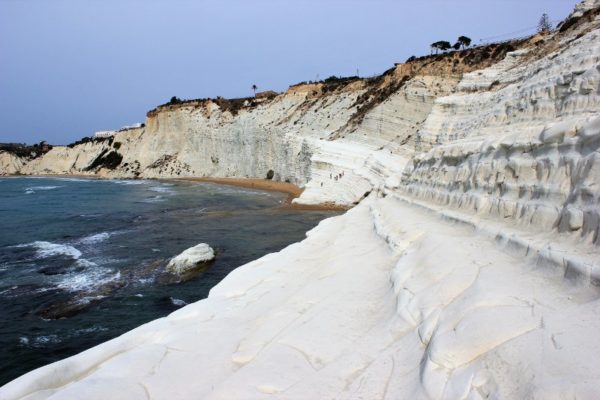
The Scala dei Turchi
As you arrive at the Scala dei Turchi, you are greeted by a long stretch of fine sandy beach. If you cast your gaze to the right, the majestic cliff immediately captures your attention.
During our visit in late October, the beach was sparsely populated, allowing us to ascend the smooth marl steps of the famous white cliff and settle at its pinnacle.
Surrounding us was a serene silence, occasionally interrupted by the cry of seagulls.
The gentle gusts of wind brushed against our cheeks, while a couple of boats remained anchored nearby.
Our eyes wandered, embracing the panoramic view extending all the way to Capo Rossello in the west.
Upon descending from the cliff, before embarking on our journey towards the Ionian coast, we took a leisurely stroll along the shoreline.
As we reached Punta Grande, we stumbled upon remnants of old wooden fishing boats, serving as tangible reminders of the area’s maritime heritage.
If you want a cool experience and see the cliff from a different view, try a boat tour to Scala dei Turchi.
Meet up for the trip is at San Leone harbor, a few kilometers south of the Valley of the Temples.
The boat tour lasts from an hour and a half to four hours, depending on what you pick when you book. The boat captain speaks English and Italian.
While on the boat, you can enjoy the sun and go for a swim to see under the water.
You can choose different times to go every day. If you can, pick the late afternoon trip, so you get to see the sunset magic on the boat.
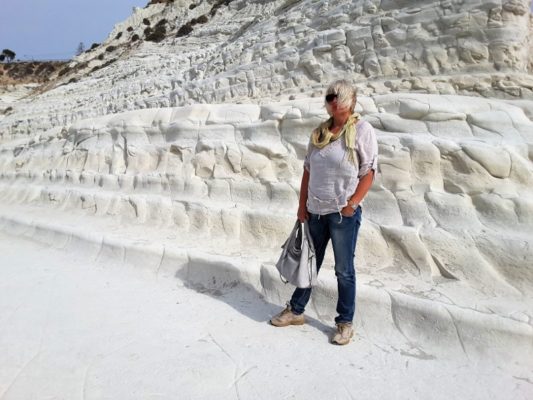
The white cliff, Scala dei Turchi
The Charms of Favara
Favara, located just 11 kilometers away from Agrigento, is a hidden gem that fate led us to discover.
In the heart of its historic center, you’ll find the Farm Cultural Park, which has been captivating visitors since June 2010.
The Farm Cultural Park is a unique attraction that combines art, culture, and community in a remarkable way.
It offers a rich and immersive experience, showcasing various artistic exhibitions, installations, and events.
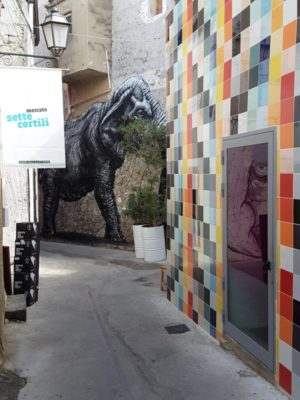
Among the alleys of the Farm Cultural Park
However, what does this independent cultural center truly represent?
Born thanks to an idea of Florinda Saieva and her husband Andrea Bartoli, t serves as a hub for art and culture, aiming to revitalize a previously neglected neighborhood and provide Favara with a brighter present and future.
Over the years, the Farm Cultural Park has restored several buildings within the area known as the Seven Courtyards.
These restored spaces now house exhibition areas, a shop, and a garden bar.
One notable feature of the Farm Cultural Park is the architecture school for children, where young learners are introduced to sustainable and environmentally friendly materials and design principles.
This unique initiative fosters creativity and educates children about innovative and responsible approaches to architecture.
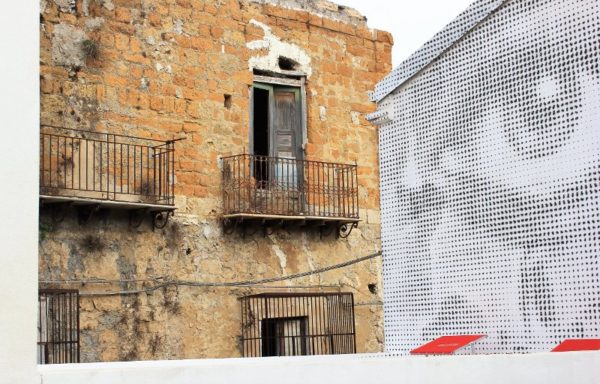
Farm Cultural Park, the old and the new
To be frank, our original intention was just to visit the Farm Cultural Park, but Favara pleasantly surprised us with its additional attractions.
As we parked our car in a slightly secluded area away from the historic center, we strolled through Piazza Cavour, a charming gathering spot in the city.
This square serves as a traditional meeting place, where elderly locals can be found seated on metal benches, engaging in friendly conversations under the shade of trees that border the perimeter of the square.

The Farm Cultural Park brochure
The square is adorned with magnificent noble palaces that add to its beauty.
At the southern corner, you’ll find the impressive Castle of Chiaromonte, originally constructed in 1270 as a leisure retreat for Frederick II of Swabia.
Recently renovated, the castle now serves as a venue for official functions and events organized by the municipality of Favara.
On the opposite side of the square stands Palazzo Fanara, an architectural gem from the 19th century.
This palace showcases a striking neoclassical style that is instantly recognizable.
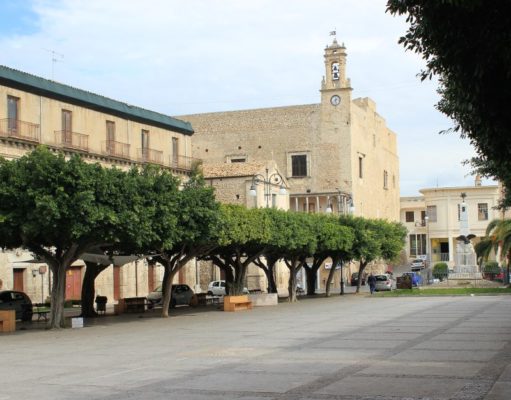
Castle of Chiaromonte, Cavour square (Favara)
As we strolled along one of the narrow streets in the center, a captivating aroma of olive oil caught our attention.
Following the scent, we stumbled upon a local olive pressing laboratory.
Intrigued by the activity taking place inside, we couldn’t resist looking through the front door. To our delight, the workers noticed our curiosity and warmly welcomed us inside.
They graciously invited us to witness the olive production process, granting us a precious glimpse into their everyday lives.
Luigi Pirandello’s Museum
Situated in the charming district of Caos di Villaseta, approximately 10 kilometers from Agrigento, is the house museum of Luigi Pirandello, a celebrated italian poet and one of my personal favorites.
This delightful residence is perched on a plateau, offering captivating views of the sea, while being embraced by lush gardens and ancient trees.
Inside the museum, visitors can explore a captivating collection of photographs, manuscripts, books, and posters related to Pirandello’s plays.
Notably, nestled at the base of a majestic pine tree, you will find the final resting place of Luigi Pirandello. The writer’s ashes find solace in a simple yet meaningful stone tomb, a poignant tribute to his legacy.



0 Comments